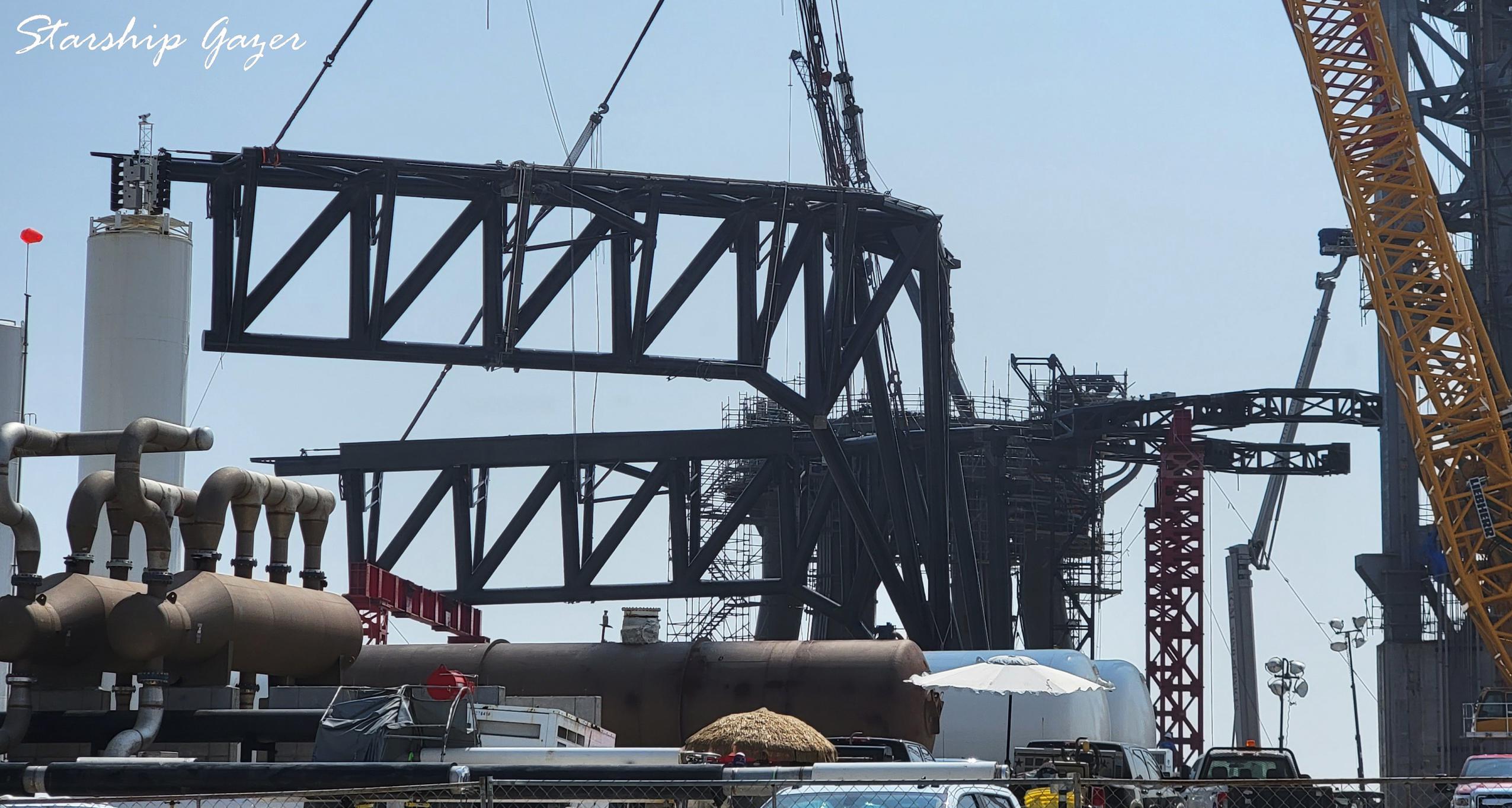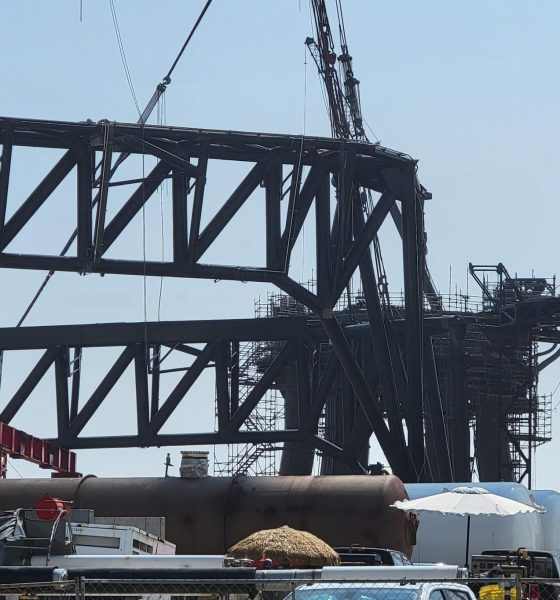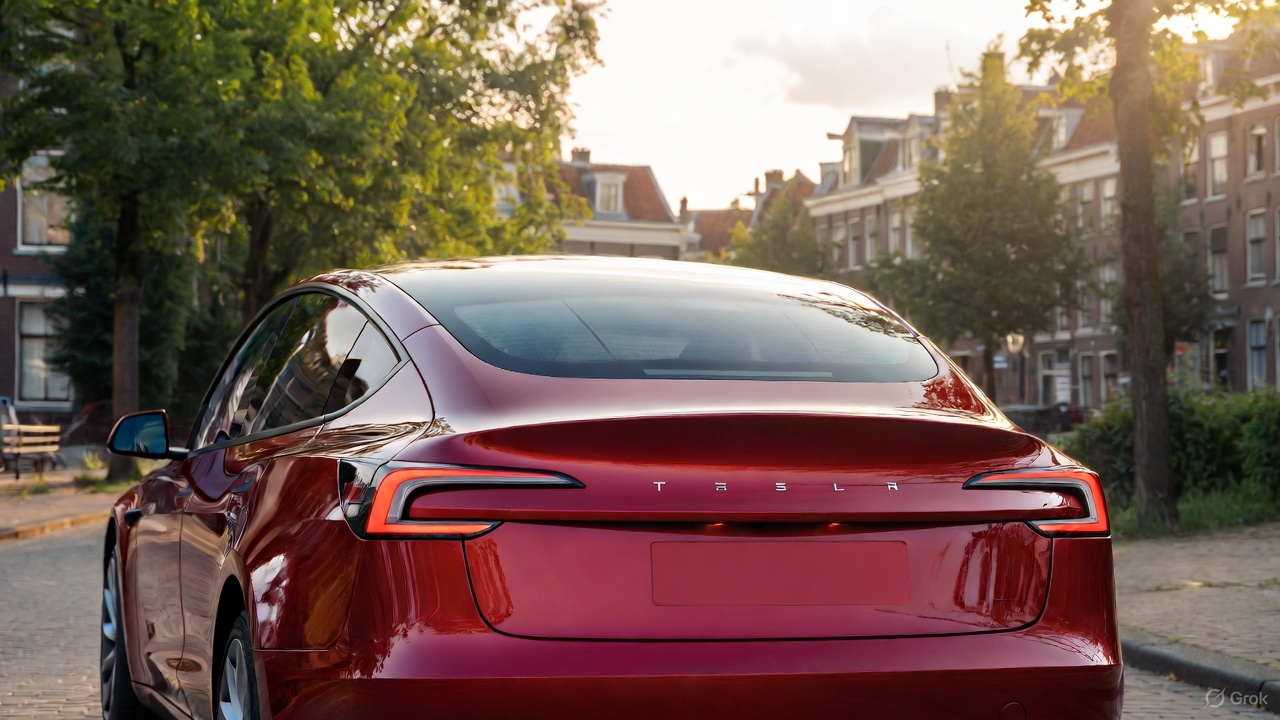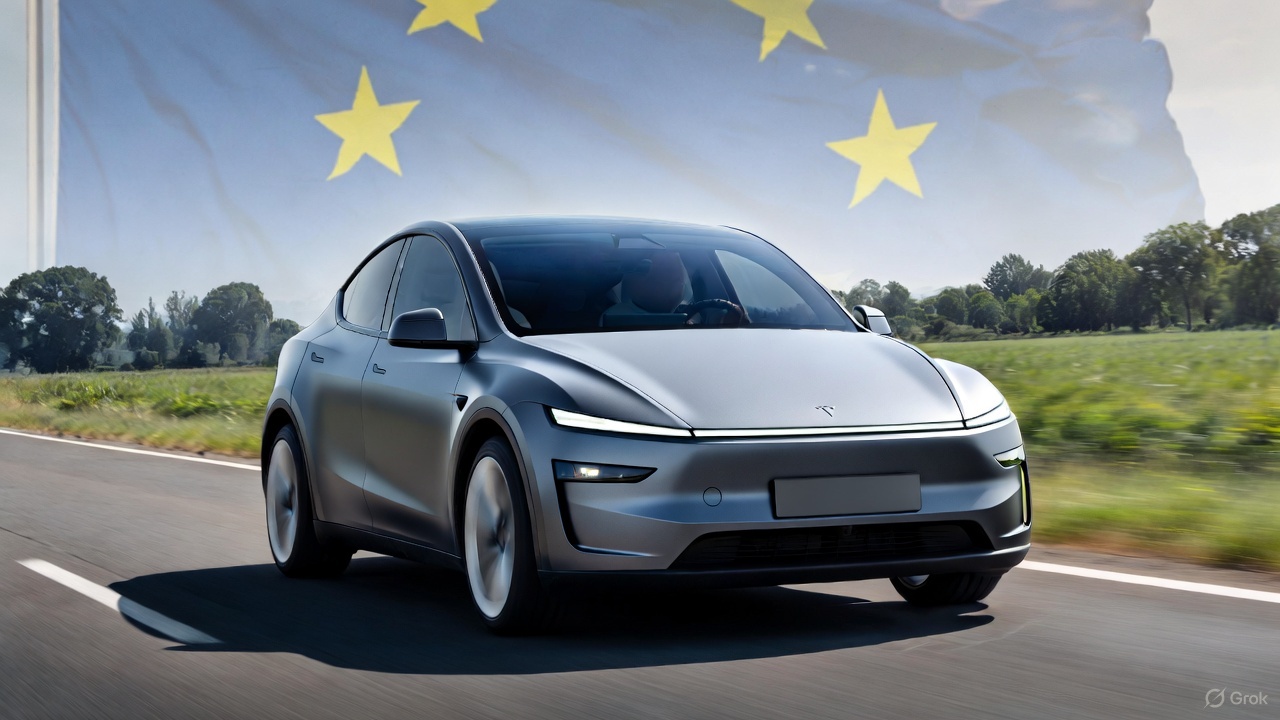

News
SpaceX’s rocket-catching ‘Mechazilla’ arms are almost ready to join Starship launch tower
Update: SpaceX has now lifted, flipped, and staged all three components of Starbase’s Mechazilla rocket-catcher, including two giant arms measuring some 36m (~120 ft) from tip to tower.
Currently hanging from both of SpaceX’s largest Starbase cranes, teams must now install massive steel pins to turn those three separate components – two arms and a carriage-like base – into an integrated structure ready for installation on the exterior of the first Starship launch tower. It’s unclear how long that might take but SpaceX is wasting no time and has already begun installing 12 ‘guide blocks’ that will allow the carriage and arms to slide up and down tracks affixed to three of four tower ‘legs.’
SpaceX has begun preparing its Starbase ‘launch tower’ for the installation of a pair of giant arms designed to lift, stack, and even catch Starships and Super Heavy boosters out of mid-air.
Deemed ‘Mechazilla’ by CEO Elon Musk, assembly of first of the structure’s three main arms only began in earnest in June 2021. That ‘quick disconnect’ (QD) arm – designed to fuel Starship and stabilize Super Heavy during Starship stacking – was installed on August 29th and followed by the addition of a claw-like appendage meant to grab onto boosters about a month later. Now, all that’s missing from Mechazilla’s first arm is the actual ‘quick-disconnect’ device that will connect to Starship’s umbilical panel to supply propellant, power, and communications links.
However, ever since Musk first hinted at the possibility of catching Super Heavy and Starship, the star of the Mechazilla show has always been its ‘chopsticks’ – SpaceX’s internal colloquialism for the pair of giant, moving arms meant to lift and catch rockets.
Prefabricated catch arm parts began to arrive at Starbase less than three months ago in the last week or two of July. Just a month later, the basic structure of both arms was practically complete, leaving another month for plumbing, wiring, and a number of smaller structural additions. Less than three months after the first parts arrived SpaceX lifted the catch arm ‘carriage’ – a sort of backbone that will hold both arms and attach to the launch tower – vertical to install it on a temporary jig.
Two days later, SpaceX lifted and flipped the first catch arm into the correct orientation with Starbase’s largest crane. To install both arms, though, it appears that SpaceX will need to have a second crane simultaneously lift and flip the second arm and move it into position so that a single giant steel pin can slot through both of their hinges. Perhaps because of the arrival of high winds on Sunday, the first (right) arm continues to hang from a crane just a few feet away from the arm carriage it will eventually be installed on, while the left arm has yet to move towards a second crane recently staged to lift it.
Ultimately, though, SpaceX is clearly ready to install both arms on the tower carriage. Once that process is complete, it appears that SpaceX will finish some minor carriage outfitting tasks before eventually installing the assembled carriage-and-arms structure onto the launch tower itself. It’s hard to say for sure but depending on the readiness of the complex system of pulleys and draw-works the tower needs to hold and move the carriage and arms, Mechazilla could effectively be fully installed and ready for testing by the end of the month. Stay tuned!

News
Tesla backtracks on strange Nav feature after numerous complaints

Tesla is backtracking on a strange adjustment it made to its in-car Navigation feature after numerous complaints from owners convinced the company to make a change.
Tesla’s in-car Navigation is catered to its vehicles, as it routes Supercharging stops and preps your vehicle for charging with preconditioning. It is also very intuitive, and features other things like weather radar and a detailed map outlining points of interest.
However, a recent change to the Navigation by Tesla did not go unnoticed, and owners were really upset about it.
For trips that required multiple Supercharger stops, Tesla decided to implement a naming change, which did not show the city or state of each charging stop. Instead, it just showed the business where the Supercharger was located, giving many owners an unwelcome surprise.
However, Tesla’s Director of Supercharging, Max de Zegher, admitted the update was a “big mistake on our end,” and made a change that rolled out within 24 hours:
The naming change should have happened at once, instead of in 2 sequential steps. That was a big miss on our end. We do listen to the community and we do course-correct fast. The accelerated fix rolled out last night. The Tesla App is updated and most in-car touchscreens should…
— Max (@MdeZegher) November 20, 2025
The lack of a name for the city where a Supercharging stop would be made caused some confusion for owners in the short term. Some drivers argued that it was more difficult to make stops at some familiar locations that were special to them. Others were not too keen on not knowing where they were going to be along their trip.
Tesla was quick to scramble to resolve this issue, and it did a great job of rolling it out in an expedited manner, as de Zegher said that most in-car touch screens would notice the fix within one day of the change being rolled out.
Additionally, there will be even more improvements in December, as Tesla plans to show the common name/amenity below the site name as well, which will give people a better idea of what to expect when they arrive at a Supercharger.
News
Dutch regulator RDW confirms Tesla FSD February 2026 target
The regulator emphasized that safety, not public pressure, will decide whether FSD receives authorization for use in Europe.

The Dutch vehicle authority RDW responded to Tesla’s recent updates about its efforts to bring Full Self-Driving (Supervised) in Europe, confirming that February 2026 remains the target month for Tesla to demonstrate regulatory compliance.
While acknowledging the tentative schedule with Tesla, the regulator emphasized that safety, not public pressure, will decide whether FSD receives authorization for use in Europe.
RDW confirms 2026 target, warns Feb 2026 timeline is not guaranteed
In its response, which was posted on its official website, the RDW clarified that it does not disclose details about ongoing manufacturer applications due to competitive sensitivity. However, the agency confirmed that both parties have agreed on a February 2026 window during which Tesla is expected to show that FSD (Supervised) can meet required safety and compliance standards. Whether Tesla can satisfy those conditions within the timeline “remains to be seen,” RDW added.
RDW also directly addressed Tesla’s social media request encouraging drivers to contact the regulator to express support. While thanking those who already reached out, RDW asked the public to stop contacting them, noting these messages burden customer-service resources and have no influence on the approval process.
“In the message on X, Tesla calls on Tesla drivers to thank the RDW and to express their enthusiasm about this planning to us by contacting us. We thank everyone who has already done so, and would like to ask everyone not to contact us about this. It takes up unnecessary time for our customer service. Moreover, this will have no influence on whether or not the planning is met,” the RDW wrote.
The RDW shares insights on EU approval requirements
The RDW further outlined how new technology enters the European market when no existing legislation directly covers it. Under EU Regulation 2018/858, a manufacturer may seek an exemption for unregulated features such as advanced driver assistance systems. The process requires a Member State, in this case the Netherlands, to submit a formal request to the European Commission on the manufacturer’s behalf.
Approval then moves to a committee vote. A majority in favor would grant EU-wide authorization, allowing the technology across all Member States. If the vote fails, the exemption is valid only within the Netherlands, and individual countries must decide whether to accept it independently.
Before any exemption request can be filed, Tesla must complete a comprehensive type-approval process with the RDW, including controlled on-road testing. Provided that FSD Supervised passes these regulatory evaluations, the exemption could be submitted for broader EU consideration.
News
Tesla says Europe could finally get FSD in 2026, and Dutch regulator RDW is key
As per Tesla, a Dutch regulatory exemption targeted for February 2026 could very well be the key gateway for a Europe-wide rollout of FSD.

Tesla has shared its most detailed timeline yet for bringing Full Self-Driving (Supervised) to Europe. The electric vehicle maker posted its update through the official X account of Tesla Europe & Middle East.
As per Tesla, a Dutch regulatory exemption targeted for February 2026 could very well be the key gateway for a Europe-wide rollout of FSD.
Tesla pushes for EU approval
Tesla stated that it has spent more than 12 months working directly with European authorities and delivering FSD demonstrations to regulators in several EU member state. Tesla highlighted a number of its efforts for FSD’s release in Europe, such as safety documentation for FSD, which is now included in its latest public Safety Report, and over 1 million kilometers of internal testing conducted on EU roads across 17 countries.
To unlock approval, Tesla is relying on the Netherlands’ approval authority RDW. The process requires proving compliance with UN-R-171 for driver-assist systems while also filing Article 39 exemptions for behaviors that remain unregulated in Europe, such as hands-off system-initiated lane changes and Level 2 operation on roads that are not fully covered by current rules. Tesla argued that these functions cannot be retrofitted or adjusted into existing frameworks without compromising safety and performance.
“Some of these regulations are outdated and rules-based, which makes FSD illegal in its current form. Changing FSD to be compliant with these rules would make it unsafe and unusable in many cases. While we have changed FSD to be maximally compliant where it is logical and reasonable, we won’t sacrifice the safety of a proven system or materially deteriorate customer usability,” Tesla wrote in its post.
Tesla targets February 2026 approval
According to Tesla, real-world safety data alone has not been considered sufficient by EU regulators, prompting the company to gather evidence to get exemptions on a specific rule-by-rule basis. RDW has reportedly committed to issuing a Netherlands National approval in February 2026, which could pave the way for other EU countries to recognize the exemption and possibly authorize local deployment of FSD.
“Currently, RDW has committed to granting Netherlands National approval in February 2026. Please contact them via link below to express your excitement & thank them for making this happen as soon as possible. Upon NL National approval, other EU countries can immediately recognize the exemption and also allow rollout within their country. Then we will bring it to a TCMV vote for official EU-wide approval. We’re excited to bring FSD to our owners in Europe soon!” Tesla wrote in its post.








